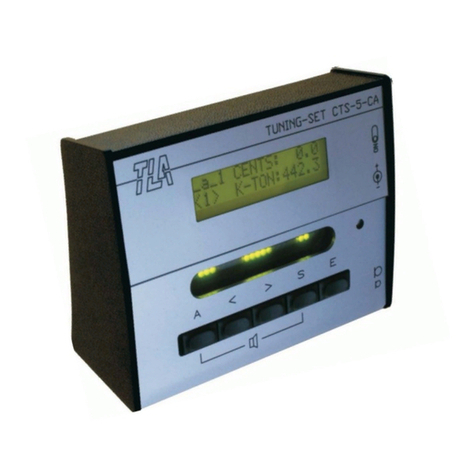
3
1.3 Selection of language for operator guidance
Your Tuning Set can converse with you in English, French, German or Italien. Select the
desired language as follows:
1. Turn off the Tuning Set.
2. While with the left hand depressing and holding the key
"S", switch on the Tuning Set. Continue depressing the
key "S" until you see this indicator.
With the "< >" key you can select your desired language. Confirm it with the "E" key.
From then on the operator guidance language displayed by the Tuning Set is in the language
you have selected. Switching the Tuning Set on or off does not change the language.
1.4 Introduction to the diagram for modes of operation
The Tuning Set is basically operated with the keys "<", ">", and "E". With the basic keys you can
find your way through the included Diagram for Modes of Operation, like on a 'city map'. You are
now, after turning on the Tuning Set, in the upper left hand corner, shown by the big black
arrow.
With the keys "<" and ">" you can move to the left and right, and select one of the following
modes:
>1< TUNING Tuning with the strobe display
>2< PITCH Mode for standard pitch adjustment
>3< CENTMESS Measuring or adjustment of a tone in cent
>4< TEMPERATURE Mode for historical temperaments
>5< STRETCHING Mode for tuning pianos
>6< MEMORY Storage of one piano tuning or one historical temperament
>7< PIANYZER Create an individual piano tuning
With the key "E" you can move downward on the diagram. The selected mode is activated. If
you press the key "E" again, you will enter the next user level or you will move upward, and are
leaving the activated mode.
Selecting the wrong key or mode will not damage the Tuning Set. The stored temperatures and
stretchings are protected and cannot be erased or changed by depression of a wrong key. In
order to become acquainted with the Tuning Set, please play and experiment with the keys to
your heart's content.
To quickly familiarize yourself with the Tuning Set, follow the examples given in part 2 on a
musical instrument, and closely stick to the guidance.
Don't try to memorize the key sequences in the examples. Try to understand the operation of
the Tuning Set by tracing the example steps on the diagram.
Note the arrow in the lower, right hand corner of the LC-Display:
When this arrow appears, the keys ">" and "<"are
used for mode selection. You are then at the highest
operating level of the diagram for operation modes.
The text in the display then shows you what you may do with the keys "<" and ">", after you
have depressed the key "E":
>1< TUNING Select a tone
>2< PITCH Select the standard pitch
>3< CENTMESS Measuring or adjustment of a tone in cent
>4< TEMPERATURE Select a historical temperament
>5< STRETCHING Select a piano stretching
>6< MEMORY Storage of one piano tuning or one historical temperament.
>7< PIANYZER Create an individual piano tuning
<1> TUNE ->
LANGUAGE
English




























